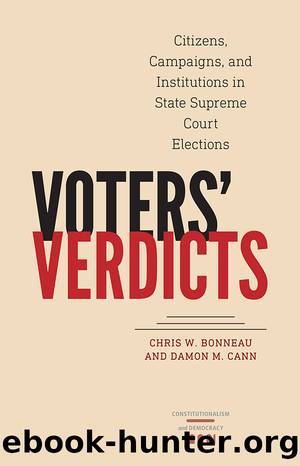Voters' Verdicts: Citizens, Campaigns, and Institutions in State Supreme Court Elections by Chris W. Bonneau & Damon M Cann

Author:Chris W. Bonneau & Damon M Cann [Bonneau, Chris W. & Cann, Damon M]
Language: eng
Format: epub
Tags: Political Science, History & Theory
ISBN: 9780813937595
Google: lS3UBAAAQBAJ
Goodreads: 23368289
Publisher: University of Virginia Press
Published: 2015-07-07T00:00:00+00:00
We run this model on data from the 166 contested state supreme court elections (from all states holding contestable judicial elections) between 1990 and 2004 that involved an incumbent.6 Standard errors for the model are clustered by state. Results of the model appear in table 4.6.
The coefficient on the variable for whether incumbency is listed on the ballot is negative, suggesting that if anything, the indicator of incumbency decreases incumbent vote share, though the effect is far from statistically significant. Rather than being helped directly by incumbency, incumbents seem to be most helped by spending more money on their campaigns (and by their opponents spending less). The lack of significance of the formal incumbency indicator should not be taken to mean that incumbents do not enjoy an advantage in state supreme court elections; rather it simply tells us that the advantage does not come from being specifically identified as such (e.g. citizensâ general preference for incumbents over non-incumbents). Instead, the incumbency advantage springs from the ability to raise more funds, better name recognition, and other such factors (e.g., Jacobson 2013).7
Conclusion
While it is well documented that judicial incumbents enjoy a host of advantages in elections (Bonneau 2005; Bonneau and Hall 2009), the results we present here suggest that being presented on the ballot as the incumbent is not among them. In our experiments, voters demonstrated no clear preference for the incumbent regardless of election format or the elected versus appointed status of the judge. This was confirmed in our observational data analysis. While surprising, our results for judicial elections square with the findings of Brown (2013), who found that in similar experimental manipulations involving congressional candidates varying the presence of an incumbent (and the incumbentâs length of tenure) and the presence of party labels had no effect on votersâ preferences between candidates. They are also consistent with the findings of Ansolabehere and Pettigrewâs (2013) manipulation of the length of tenure in Congress on citizensâ preferences for hypothetical candidates described in experimental vignettes. The results also square with the findings of Klein and Baum (2001), who had listed candidates by occupation rather than by a formal indicator of incumbency on a simulated ballot.
This is not to say that incumbency is unimportant. A host of structural advantages in terms of running an effective campaign, a developed fund-raising network, name recognition, and more combine to give incumbents a formidable electoral advantage. Our results do suggest, however, that voters do not presume that all else being equal, an incumbent is a better candidate than a non-incumbent. The combination of experimental and observational evidence makes us quite confident in this conclusion.
This finding has interesting normative implications for candidates seeking judicial office. If incumbency in itself were the source of the formidable incumbency advantage, there would be little a judicial candidate could do. However, given that the structural advantages of judicial incumbency seem to stem instead from factors such as name recognition and fund-raising, it seems that a quality challenger with a strong reputation and fund-raising aptitude
Download
This site does not store any files on its server. We only index and link to content provided by other sites. Please contact the content providers to delete copyright contents if any and email us, we'll remove relevant links or contents immediately.
What's Done in Darkness by Kayla Perrin(26615)
The Fifty Shades Trilogy & Grey by E L James(19095)
Shot Through the Heart: DI Grace Fisher 2 by Isabelle Grey(19079)
Shot Through the Heart by Mercy Celeste(18952)
Wolf & Parchment: New Theory Spice & Wolf, Vol. 10 by Isuna Hasekura and Jyuu Ayakura(17131)
Python GUI Applications using PyQt5 : The hands-on guide to build apps with Python by Verdugo Leire(17019)
Peren F. Statistics for Business and Economics...Essential Formulas 3ed 2025 by Unknown(16894)
Wolf & Parchment: New Theory Spice & Wolf, Vol. 03 by Isuna Hasekura and Jyuu Ayakura & Jyuu Ayakura(16840)
Wolf & Parchment: New Theory Spice & Wolf, Vol. 01 by Isuna Hasekura and Jyuu Ayakura & Jyuu Ayakura(16467)
The Subtle Art of Not Giving a F*ck by Mark Manson(14382)
The 3rd Cycle of the Betrayed Series Collection: Extremely Controversial Historical Thrillers (Betrayed Series Boxed set) by McCray Carolyn(14157)
Stepbrother Stories 2 - 21 Taboo Story Collection (Brother Sister Stepbrother Stepsister Taboo Pseudo Incest Family Virgin Creampie Pregnant Forced Pregnancy Breeding) by Roxi Harding(13669)
Scorched Earth by Nick Kyme(12785)
Drei Generationen auf dem Jakobsweg by Stein Pia(10980)
Suna by Ziefle Pia(10902)
Scythe by Neal Shusterman(10366)
The Ultimate Python Exercise Book: 700 Practical Exercises for Beginners with Quiz Questions by Copy(10223)
De Souza H. Master the Age of Artificial Intelligences. The Basic Guide...2024 by Unknown(10185)
D:\Jan\FTP\HOL\Work\Alien Breed - Tower Assault CD32 Alien Breed II - The Horror Continues Manual 1.jpg by PDFCreator(10180)
